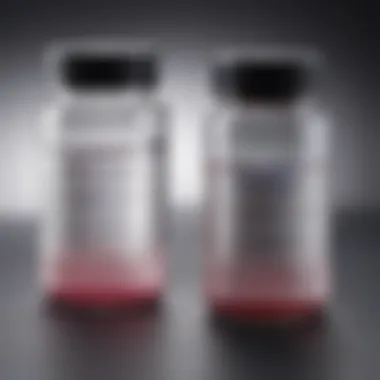In-Depth Analysis of the Qiagen Multiplex PCR Kit


Overview of Research Topic
Brief Background and Context
The advent of polymerase chain reaction (PCR) technology has revolutionized molecular biology since its inception in the 1980s. PCR allows for the amplification of specific DNA sequences, making it a cornerstone technique in genetics and molecular diagnostics. Among the various advancements in PCR, multiplex PCR stands out. This method enables the simultaneous amplification of multiple targets within a single reaction, thereby increasing efficiency and reducing the potential for contamination. The Qiagen multiplex PCR kit has emerged as a leading product in this arena, catering to researchers looking to optimize their studies in various areas, from forensic science to clinical diagnostics.
Importance in Current Scientific Landscape
In an age where rapid and accurate diagnostic methods have never been more critical, the Qiagen multiplex PCR kit provides significant advantages over conventional PCR approaches. This kit not only conserves resources but also expands the scope of research possibilities. As the global focus shifts toward precision medicine and personalized therapies, understanding the potential of multiplex PCR is essential. The integrations of multiple targets can lead to enriched data sets that facilitate comprehensive analyses of complex biological systems.
Methodology
Research Design and Approach
This article adopts a qualitative research design, analyzing the features and applications of the Qiagen multiplex PCR kit through existing literature, user experiences, and case studies. The intent is to synthesize diverse insights to provide a holistic view of the product's functionality and utilities.
Data Collection Techniques
Data is collected via systematic reviews of peer-reviewed journals, white papers, and product manuals. User testimonials and comparisons with similar kits are also evaluated to assess the tool's practicality and efficiency. The use of case studies highlights real-world applications, showcasing both successful and challenging implementations. Collectively, this data presents a nuanced perspective on the Qiagen multiplex PCR kit's significance in contemporary research.
Foreword to Multiplex PCR
Multiplex PCR represents a significant leap forward in the realm of molecular biology. It allows for the simultaneous amplification of multiple DNA targets in a single reaction, which increases both efficiency and productivity in laboratory settings. This technique not only conserves resources but also reduces the time needed to obtain results. Understanding multiplex PCR is essential for researchers and professionals alike, as it simplifies complex processes that would otherwise require multiple individual reactions.
Definition and Purpose
Multiplex PCR refers to a variation of the standard Polymerase Chain Reaction (PCR) that enables the amplification of several specific DNA sequences at once. The purpose of this technique is to maximize the amount of genetic information obtained from a single sample, thereby improving data collection in various applications such as diagnostics and genetic research. By using multiple primers, researchers can target different regions of the genome, increasing the breadth of analysis per experiment.
In diagnostic applications, multiplex PCR can streamline the detection of pathogens by identifying multiple infectious agents simultaneously. This is advantageous in clinical settings, where rapid and accurate results can lead to more effective treatments. The method is particularly useful for detecting co-infections or genetic disorders with multiple loci of interest.
Comparison with Traditional PCR
Traditional PCR typically involves the amplification of one DNA target per reaction. This can be limiting in terms of the amount of information garnered from a single sample. In contrast, multiplex PCR offers several key benefits:
- Efficiency: By amplifying multiple targets in one go, researchers save time and reagents.
- Reduced Risk of Contamination: Fewer reaction setups mean lower chances for contamination across samples.
- Enhanced Data Collection: Multiplexing provides more comprehensive data, which is especially useful in research settings.
However, multiplex PCR is not without its challenges. The complexity of designing appropriate primers for multiple targets can introduce difficulties, such as non-specific amplification or decreased sensitivity. Researchers must carefully optimize reaction conditions to mitigate these issues and ensure reliable results.
In summary, the understanding of multiplex PCR is crucial for modern molecular biology practices. It harmonizes efficiency with data richness, catering to the evolving demands of both clinical and research contexts.
Overview of the Qiagen Multiplex PCR Kit
The Qiagen Multiplex PCR Kit stands as an essential tool in the realm of molecular biology. This kit is designed for the simultaneous amplification of multiple targets within a single PCR reaction. Its significance can be appreciated across various scientific disciplines, where efficient sample processing is vital.
Components of the Kit
Understanding the components of the Qiagen Multiplex PCR Kit is crucial for its effective utilization. The kit typically includes:
- Master Mix: This is a ready-to-use mix containing crucial reagents like DNA polymerase, dNTPs, salts, and buffers. The composition is tailored to optimize amplification efficiency.
- Primers: Specific to the target sequences, these short DNA fragments are essential for directing the amplification process. The primers are often included in predetermined sets to ensure specificity.
- Control DNA: Positive and negative controls are provided to verify the integrity and functionality of the amplification.
- Instructions: Comprehensive manuals guide users through setup and execution, ensuring accuracy.
All the components work synergistically to ensure reliable and reproducible results. Understanding each part's role can enhance the effectiveness of multiplex PCR, thereby benefiting various applications in diagnostics and research.
User Instructions
Following appropriate user instructions is vital for the success of any PCR experiment. The Qiagen Multiplex PCR Kit comes with detailed guidelines. Some critical steps include:


- Preparation: Gather all necessary components. Ensure the workspace is clean to avoid contamination.
- Mixing: Combine the master mix with the primer sets and template DNA according to the specifications. This step is crucial for optimal target amplification.
- Thermal Cycling: Input the prepared mixture into a thermal cycler. The cycling conditions are essential and typically involve initial denaturation, followed by amplification cycles, and ending with a final extension.
- Analysis: Post-PCR analysis through gel electrophoresis or other methods is required to confirm amplification success.
These instructions are designed to maximize the performance while minimizing potential errors during the process. Following the guidelines precisely enhances the quality of results and maintains the integrity of the scientific inquiry.
Mechanism of Action
The mechanism of action is crucial for understanding how the Qiagen Multiplex PCR Kit works. It details the scientific principles that underpin the polymerase chain reaction process and the specific amplification strategies employed in multiplex PCR. By grasping these fundamentals, users can optimize their experimental designs and troubleshoot common issues. This section aims to elucidate these mechanisms, providing insights into how they directly impact functionality, efficiency, and accuracy in diverse applications.
Polymerase Chain Reaction Process
The polymerase chain reaction (PCR) is a widely utilized technique in molecular biology. It enables the amplification of specific DNA sequences, allowing researchers to work with minute amounts of genetic material. The process involves several critical steps:
- Denaturation: The double-stranded DNA is heated to approximately 94-98°C, causing the hydrogen bonds between the strands to break and resulting in two single strands.
- Annealing: The temperature is lowered to about 50-65°C. During this phase, primers attach to the target sequences on the single-stranded DNA. Precise temperature settings are vital here.
- Extension: The temperature is raised to 72°C, optimal for Taq polymerase activity. This enzyme adds nucleotides to the primers, creating new strands of DNA. The result is an exponential increase in the target DNA segment.
This cyclical process allows for the creation of millions of copies of a specific DNA sequence in a matter of hours, making it a powerful tool for various applications. Understanding each step is essential for efficient use of the Qiagen Multiplex PCR Kit, ensuring accurate results.
Amplification Strategy in Multiplex PCR
Multiplex PCR distinguishes itself from traditional PCR by enabling the simultaneous amplification of multiple target sequences within a single reaction. The strategy involves the use of multiple primer sets, each specific to a different target gene. Key components include:
- Design of Primers: Primers must be carefully designed to ensure specificity and to avoid overlap with other primers. In multiplex PCR, primer design involves balancing various factors such as melting temperature and GC content.
- Optimized Conditions: Multiplex PCR requires specific considerations regarding reaction conditions. The concentration of each primer must be adjusted to minimize competition between targets, thus maximizing amplification efficiency.
Using optimal conditions in multiplex PCR can significantly enhance the sensitivity and specificity of the amplification process.
- Dual-Color Detection: The use of fluorescent dyes in combination with multiplex PCR allows for the quantitative analysis of multiple genes. Each target can be detected and quantitated simultaneously, a feature crucial in diagnostics and research.
This sophisticated strategy has made multiplex PCR a mainstay in various fields, including diagnostics, where resource efficiency is paramount. Understanding its amplification strategy can lead to better experimental outcomes.
Applications of the Qiagen Multiplex PCR Kit
The Qiagen Multiplex PCR Kit serves diverse purposes across multiple fields. Its ability to amplify several target sequences from a single reaction makes it a remarkable tool. This versatility enhances both research and practical applications significantly. High throughput capacity and precision in quantification are essential features that distinguish this kit. Understanding its applications provides insights into why researchers choose it and how it contributes to advancements in molecular biology.
Diagnostic Applications
The diagnostic applications of the Qiagen Multiplex PCR Kit are pivotal. This kit is frequently employed in medical diagnostics. It allows simultaneous detection of multiple pathogens, which is crucial in infectious disease management. For instance, in viral and bacterial infections, quick and accurate identification can influence treatment strategies dramatically.
Moreover, in genetic testing, the ability to amplify specific sequences aids hereditary condition screenings. This has implications in pre-natal diagnostics, tumor profiling, and more.
Simultaneous amplification of various targets optimizes time and resource allocation in laboratories.
Research Applications
In academic and industrial research, the Qiagen Multiplex PCR Kit demonstrates versatile capabilities. Its functionality is not limited to medical fields. In agricultural research, it aids the study of plant pathogens, supporting efforts in crop resilience. This amplifies its utility across biotechnology and genetic engineering contexts as well.
Additionally, in evolutionary biology, multiplex PCR enables the examination of genetic variations within species. As a result, insights into phylogenetic relationships can be uncovered, enriching our understanding of biodiversity.
Forensic Analysis
Forensic analysis benefits significantly from the Qiagen Multiplex PCR Kit. In criminal investigations, it can amplify DNA from trace samples. This is particularly useful in cases where biological material is limited. Many forensic labs utilize this kit to match genetic profiles of suspects with evidence collected at crime scenes.
Furthermore, in paternity testing or missing persons cases, the kit simplifies the process of obtaining definitive results. The ability to analyze multiple loci simultaneously ensures higher accuracy and reliability in results.
Environmental Testing
Environmental testing is another critical area where the Qiagen Multiplex PCR Kit proves valuable. It can detect specific genetic markers of microorganisms in various samples, such as soil, water, and sediments. This application is crucial for monitoring microbial populations in ecosystem health studies.


Additionally, in the field of bioremediation, it helps assess the presence of genetically modified organisms. This is important for ensuring compliance with environmental regulations and understanding the impact of human activity on natural habitats.
Benefits of Using Qiagen Multiplex PCR Kit
Multiplex PCR technology provides researchers with distinct advantages that are pivotal in molecular biology. The Qiagen Multiplex PCR Kit stands out as an essential tool in this regard. This section explores the key benefits that this kit offers, particularly in terms of efficiency, cost, sensitivity, and specificity.
Increased Efficiency
One of the primary benefits of the Qiagen Multiplex PCR Kit is the significant increase in efficiency it offers to molecular biology workflows. Traditional PCR generally requires multiple reactions for different targets, consuming both time and resources. In contrast, the Qiagen kit allows simultaneous amplification of multiple DNA targets within a single reaction.
This capability reduces the number of individual experiments that need to be conducted, consequently saving time and labor. Furthermore, processing multiple samples at once decreases the turnaround time for results, which can be crucial in clinical diagnostics and research settings. By maximizing the reaction setup, Qiagen helps streamline laboratory protocols and enhance productivity, reducing overall operational workload.
Cost-Effectiveness
Cost considerations are crucial for any research facility or lab. The Qiagen Multiplex PCR Kit is designed to offer a cost-effective solution for molecular diagnostic applications. By enabling multiplexing, the kit minimizes the materials needed for each reaction.
Fewer reagents required means less overall expenditure on consumables. Additionally, the reduction in analytical time and the associated labor costs also contribute to overall savings. This feature is particularly beneficial for labs that process a large quantity of samples. Labs can achieve more with their existing budgets, making the kit an appealing option for institutions seeking cost-efficiency without sacrificing quality.
Improved Sensitivity and Specificity
Sensitivity and specificity are critical parameters in PCR methodology, and the Qiagen Multiplex PCR Kit excels in both. Enhanced sensitivity allows for the detection of low-abundance targets that may otherwise go undetected using traditional PCR methods. This is particularly relevant in diagnostic applications where the accurate identification of pathogens or genetic mutations is essential.
Moreover, the specificity of the Qiagen kit minimizes the chances of non-specific amplification. This is achieved by optimizing conditions for each primer pair, which reduces background noise and improves the reliability of the results. As a result, researchers and clinicians can be more confident in their findings, leading to better-informed decision-making in treatment and research strategies.
In summary, the Qiagen Multiplex PCR Kit delivers enhanced efficiency, cost-effectiveness, and improved sensitivity and specificity, making it a vital asset in molecular biology laboratories.
By integrating these benefits into their workflows, organizations can optimize their research capabilities and amplify their scientific contributions.
Limitations and Considerations
Understanding the limitations and considerations of the Qiagen Multiplex PCR Kit is crucial for optimizing its effectiveness in various applications. While the kit boasts numerous advantages including increased efficiency and improved specificity, there are specific elements that users must navigate to fully utilize its potential. Addressing these considerations can enhance experimental outcomes and ultimately lead to more reliable data. Below are two critical areas that demand attention.
Potential Interference Issues
One of the primary challenges in multiplex PCR is the possibility of interference among different primer sets. Interference occurs when the presence of one or more primers affects the efficiency of the others, leading to suboptimal amplification. Such issues can arise from non-specific binding or competition for reagents during the amplification process.
To mitigate these risks, it is advisable to:
- Optimize primer design to ensure specificity.
- Employ appropriate concentrations of primers and target DNA to avoid competition.
- Use high-quality reagents and enzymes that increase robustness.
Researchers should also consider the buffer composition and cycling conditions, as these parameters could influence the performance of the assay significantly. Using gradient PCR can help in identifying specific annealing temperatures optimal for each set of primers.
"Interference among primers can lead to inaccurate results; careful optimization is essential."
Optimal Conditions for Use
For the Qiagen Multiplex PCR Kit to perform at its best, establishing optimal conditions is non-negotiable. This involves a careful assessment of various factors such as DNA template quality, primer concentration, and cycling conditions.
Some essential conditions to consider include:
- Template Quality: High-quality genomic DNA or cDNA must be used. Contaminated or degraded samples can reduce amplification efficiency.
- Primer Concentration: Finding the right balance in the concentration of primers is key. Too high concentration may cause non-specific binding, while too low can lead to insufficient signal.
- Thermal Cycling Conditions: The correct annealing temperature must be established through preliminary experiments. Default settings may not be suitable for all samples or primer combinations.
Troubleshooting Common Issues
Troubleshooting common issues is a crucial aspect when working with the Qiagen Multiplex PCR Kit. Understanding potential problems can save both time and resources during experimentation. It also enhances the reliability of results obtained. Non-specific amplification and lower than expected yield are among the most common issues faced by researchers. By identifying the underlying causes and implementing corrective strategies, one can achieve optimal performance from the kit.


Non-Specific Amplification
Non-specific amplification occurs when more than the intended target DNA is amplified during the PCR process. This can lead to unreliable results, making it difficult to interpret data. There are several reasons for non-specific amplification. First, inadequate primer design can lead to binding at unintended sites. Primers should be carefully evaluated for specificity against the target sequences.
Furthermore, reaction conditions play a significant role in non-specific amplification. Higher concentrations of magnesium ions can promote non-specific interactions. It is advisable to optimize the magnesium concentration for each specific reaction. Additionally, the annealing temperature needs careful adjustment. A lower temperature might allow non-specific binding, while a higher temperature may hinder amplification. It is essential to conduct temperature gradient tests to determine the optimal annealing temperature.
In summary, to minimize non-specific amplification, focus on the following aspects:
- Ensure proper primer design and specificity.
- Optimize the concentration of magnesium ions in the reaction.
- Conduct temperature gradient tests for ideal annealing conditions.
Lower than Expected Yield
Obtaining a lower yield than anticipated during PCR can be frustrating. Several factors may contribute to this issue, making it essential to evaluate each step of the process. First, check the quality of the DNA template. Degraded or low-concentration DNA can hinder amplification efficiency. Performing a quantity assessment using spectrophotometry may help confirm the DNA quality.
Another crucial factor is the number of cycles. Insufficient cycles may not produce enough amplified product. However, excessive cycles can lead to saturation and reduce yield. The cycle number should be determined based on the specific experimental requirements.
Moreover, improper handling and contamination can adversely affect yield. Always ensure that pipetting techniques are accurate. Using filters in pipette tips can reduce the risk of contamination that may inhibit PCR progress.
To address lower than expected yield, consider the following:
- Assess the DNA template quality and concentration.
- Determine the optimal number of PCR cycles.
- Use accurate pipetting techniques and minimize contamination risks.
By paying attention to these common issues, researchers can refine their approach, ultimately leading to more successful and reliable outcomes in their work with the Qiagen Multiplex PCR Kit.
Recent Advances in PCR Technology
Recent advances in polymerase chain reaction (PCR) technology have significantly transformed molecular biology. These advancements enhance speed, accuracy, and versatility in various applications. Understanding these developments is crucial for researchers and practitioners who rely on multiplex PCR for diagnostics, gene studies, and forensic analyses.
Innovations in Multiplex PCR Protocols
The field of multiplex PCR has witnessed several innovations aimed at improving its efficacy. Notably, advancements in reaction buffers and enzyme formulations have resulted in more efficient amplification of multiple targets simultaneously. New polymerases with higher fidelity and processivity minimize errors during amplification. Additionally, evolving primers, which now incorporate unique molecular barcodes, allow for easier identification and quantification of different sequences in one reaction.
Benefits of these innovations include:
- Increased throughput: Simultaneous amplification of several targets saves time and resources.
- Reduced sample consumption: Lower amounts of nucleic acids are required, which is crucial when dealing with limited samples.
- Enhanced assay specificity: The integration of dual-labeled probes improves discrimination between closely related sequences.
Emerging Trends in PCR Applications
PCR applications continue to expand. Emerging trends illustrate the wider implications of PCR technology in diverse fields:
- Personalized medicine: PCR assays are tailored for specific patient genotypes, improving treatment effectiveness.
- Portable PCR devices: Miniaturized devices enable real-time analysis in field settings, essential for environmental and public health monitoring.
- Metagenomic studies: Multiplex PCR facilitates the assessment of complex microbial populations from environmental samples, revealing insights into biodiversity and ecosystem health.
Technological advancements in PCR represent a crucial evolution, promising more reliable results and broader application ranges in clinical diagnostics, research, and environmental science.
These trends highlight the importance of remaining current with PCR advancements, ensuring that methodologies align with contemporary scientific demands.
End
The conclusion of this article encapsulates the vital role the Qiagen multiplex PCR kit holds in molecular biology. This technology is not merely a tool but a significant asset in various scientific endeavors, from diagnostics to environmental testing. Summarizing the key points provides clarity for readers to grasp the essential functions, benefits, and limitations inherent to the kit.
Summary of Key Points
Throughout the article, several fundamental aspects of the Qiagen multiplex PCR kit have been discussed:
- Functionality: This kit enhances the efficiency of PCR by allowing simultaneous amplification of multiple targets in a single reaction. This innovation is crucial for applications requiring high throughput.
- Applications: The range spans across diagnostics, research, forensics, and environmental testing, showcasing its versatility.
- Benefits: Increased efficiency, cost-effectiveness, sensitivity, and specificity are crucial advantages that set this kit apart from traditional PCR methods.
- Limitations: While the kit is robust, potential interference issues and the necessity for optimal conditions highlight the need for careful experimental design.
These points not only highlight the strengths of the Qiagen multiplex PCR kit but also inform users about the necessary precautions required to maximize its capabilities.
Future Directions in Research and Application
The future of multiplex PCR technology seems promising. Research is likely to focus on the following areas:
- Improved protocols: Innovations in amplification strategies and polymerase enhancements could further increase the efficiency and accuracy of multiplex PCR.
- Integration with other technologies: Combining multiplex PCR with high-throughput sequencing or digital droplet PCR may pave the way for more precise genetic analyses.
- Expanded applications: As our understanding of genetics evolves, the applications of multiplex PCR will likely extend into more complex areas such as personalized medicine and real-time environmental monitoring.



